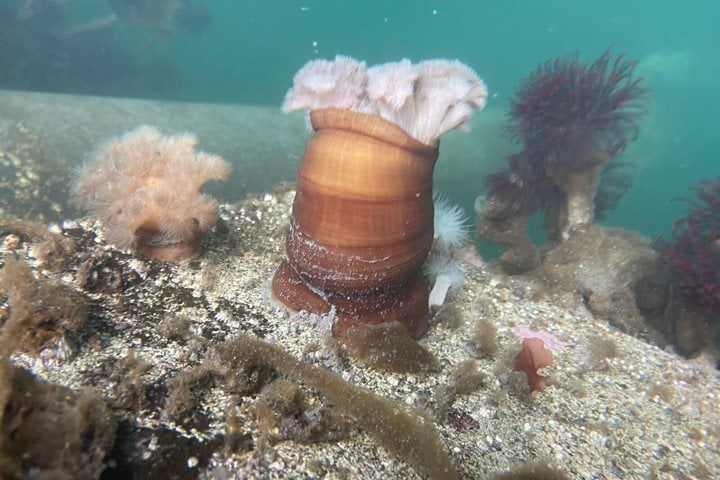Sunny days and bluebird skies are not the norm in Southeast Alaska. Days like those do happen, and we do experience them during our excursions here. But days of mist and ceilings of clouds that hide the sun more truly represent the character of this part of the world — and that is what we woke up to today. It was not a day for blue skies.
Over the course of the night, we left Glacier Bay National Park and crossed Icy Strait. Once enveloped by great glaciers, the strait and sound are open and serve as one of the few channels for water to flow between the Inside Passage and the open ocean. It is also here that wildlife congregates. Our intention for the morning was to set off on rounds of Zodiac trips from National Geographic Quest, which anchored in a protected bay amongst a set of islands called the Inian Islands.
The fog was low and dense as we set off during the rounds. We quickly discovered how teeming with life the environment here is: sea lions belched and roared from rocky outcroppings, cormorants circled around vertical cliffs, and gulls yelped from island perches.
Close to the islands in shallow, sheltered coves, kelp grows. Looking carefully among the floating bulbs of kelp, we noticed that sea otters had woven themselves into the ribbons of kelp. This adaptation helps the sea otters to rest without being swept elsewhere by the current, and ensures that they are always close to their preferred habitat. Sea otters feed primarily on slow-moving and abundant prey, such as sea stars and sea urchins, both of which live in the kelp forests.
By the end of the morning, all parties of Zodiacs had seen sea otters, sea lions, and bald eagles. Around National Geographic Quest humpback whales fed, allowing all members of our voyage to see whales from the Zodiacs or the ship.
During lunch, the deck team lifted anchor and repositioned the ship to nearby George Island. This is a small island with an inviting beach for landing boats. It has canopies of hemlocks and Sitka spruce, and forest floors of mushrooms, mosses, ferns, and lichens. It is also the site of a World War II gun; it was installed to protect the villages and cities of the Inside Passage from attack by the Japanese during the war. We spent the afternoon here, exploring. Kayaks and paddleboards were brought to the beach and set up for the arrival of our guests.
While guests were kayaking and paddleboarding, some encountered sea lions and even a distant humpback whale. Hikers traversed a well-maintained trail, stopping at vistas to gaze out over the eastern edge of the open Gulf of Alaska. Most groups visited the gun site. Many of the kids on our voyage are part of the Global Explorer program; they spent part of their time around George Island learning how to drive Zodiacs with their expedition leader and field educator.
Following the hikes, kayaking, and paddleboarding, many guests participated in the polar plunge. This dip into chilly Alaskan water is a Lindblad tradition. Many of the younger guests stayed in the water for impressive amounts of time before getting out to return to the ship. After supper, one of our geologists gave a fun and lighthearted presentation on animal names.







